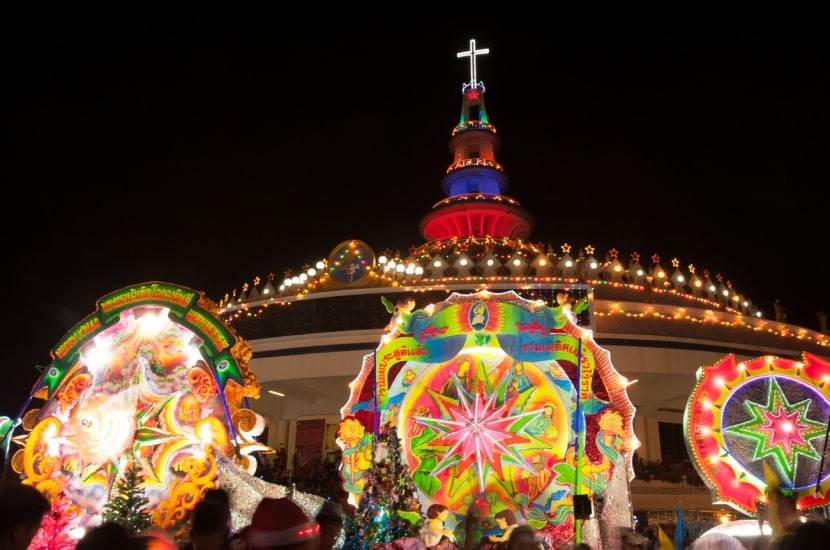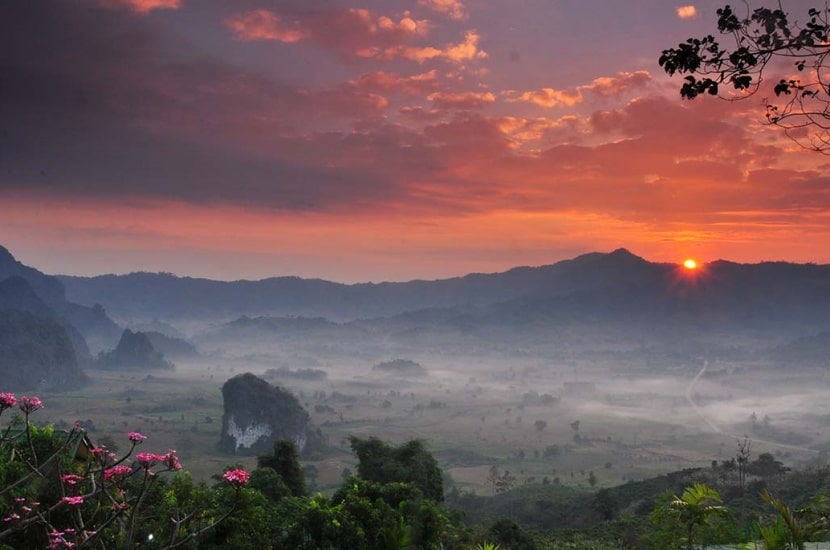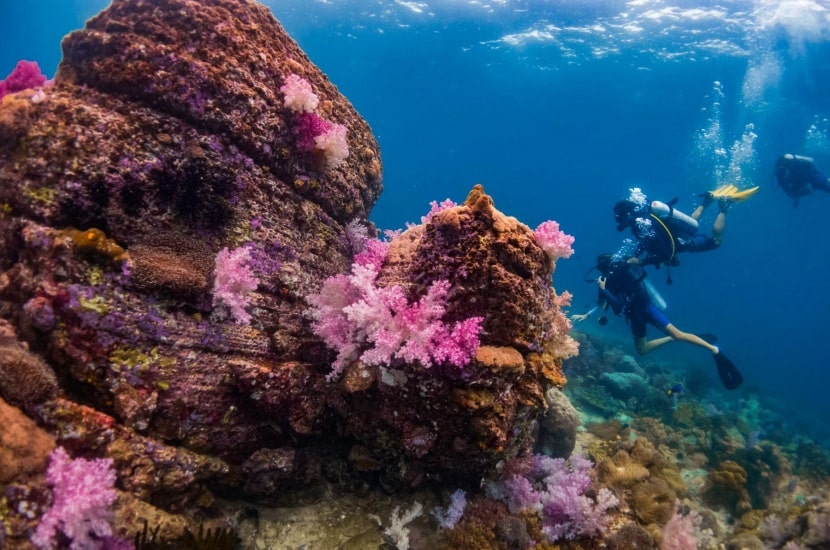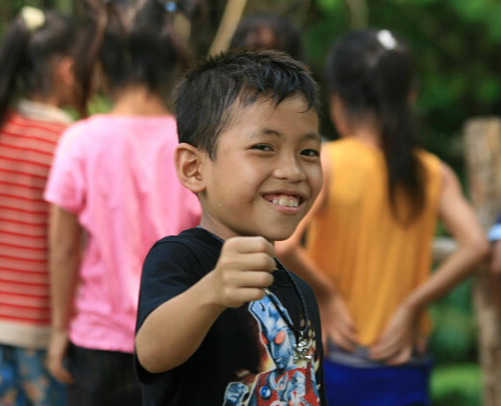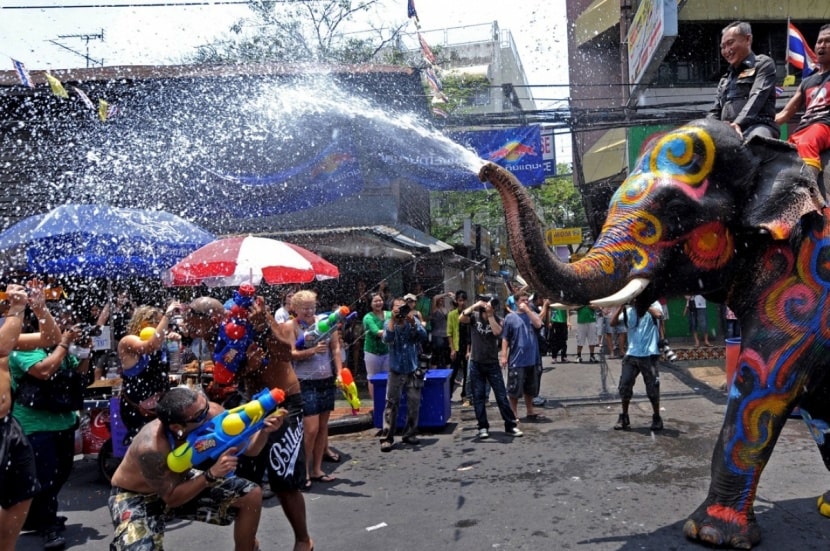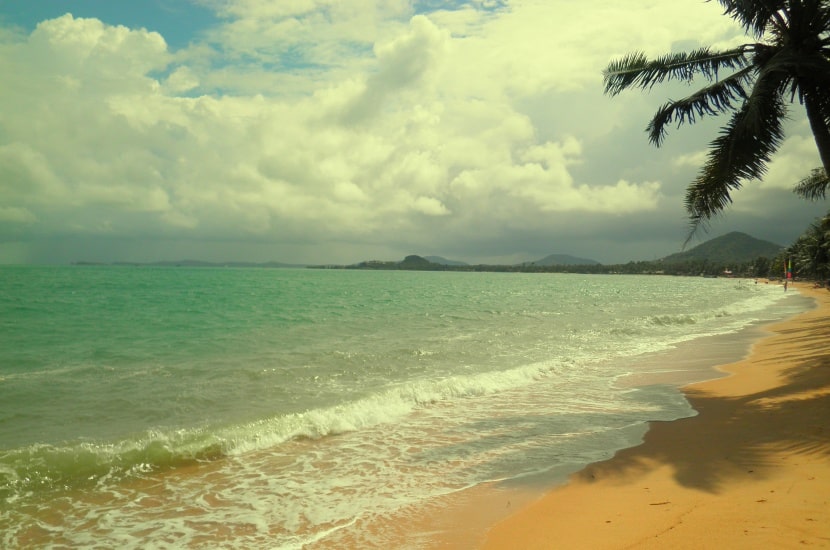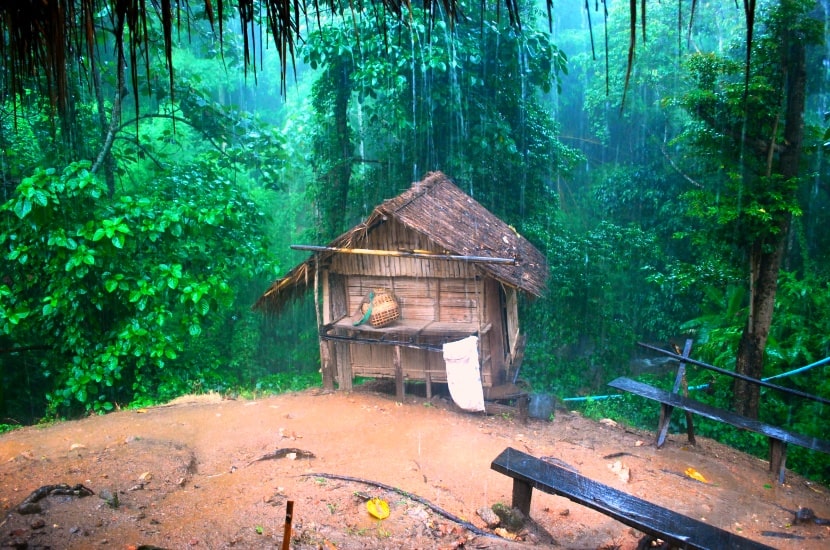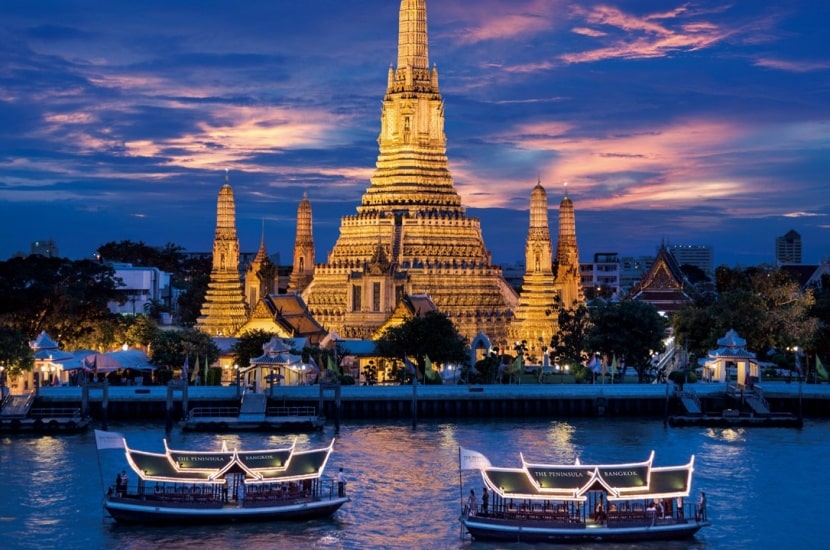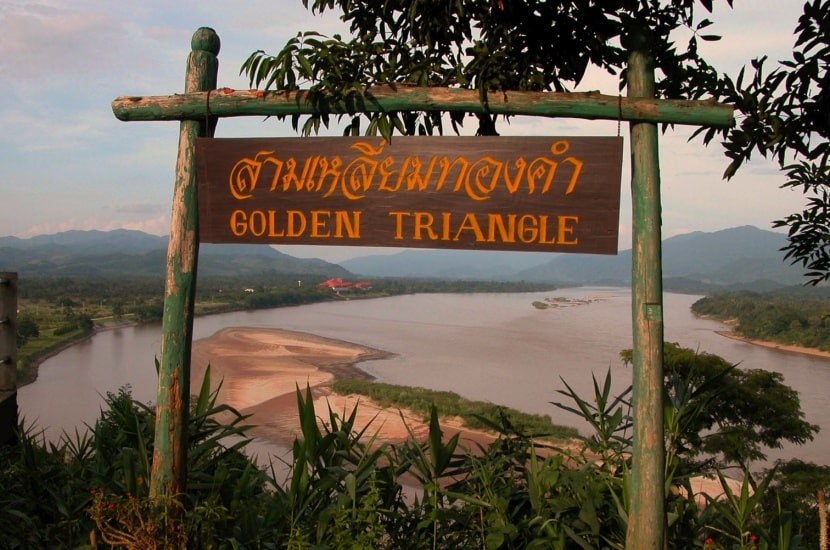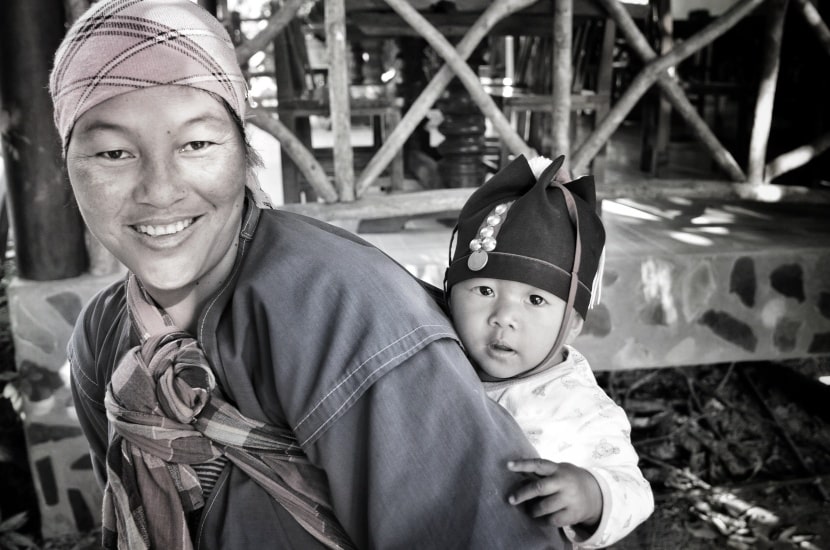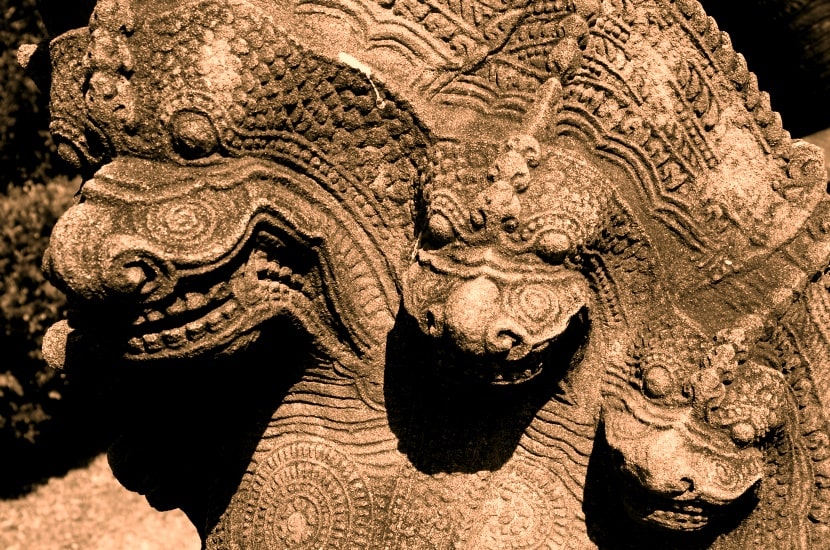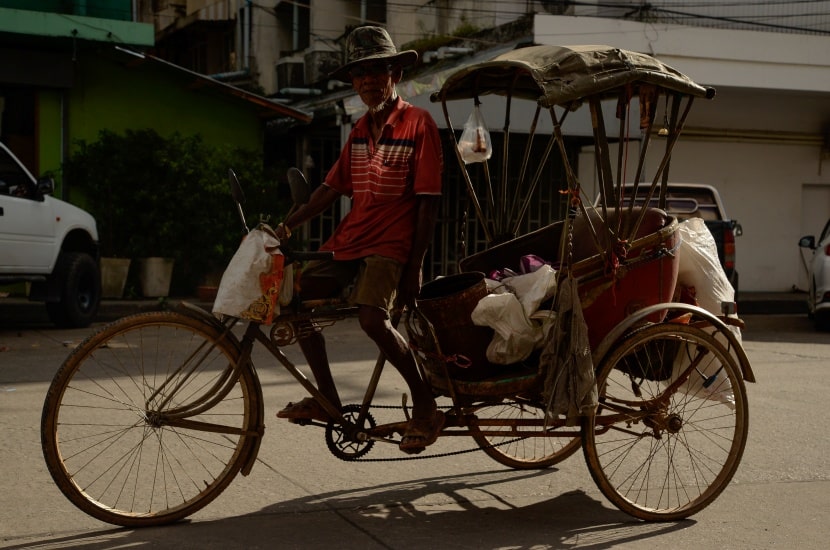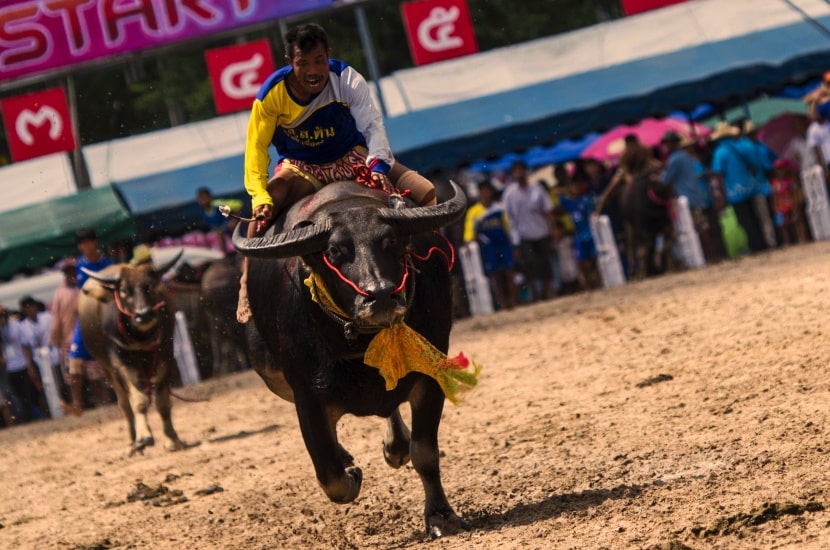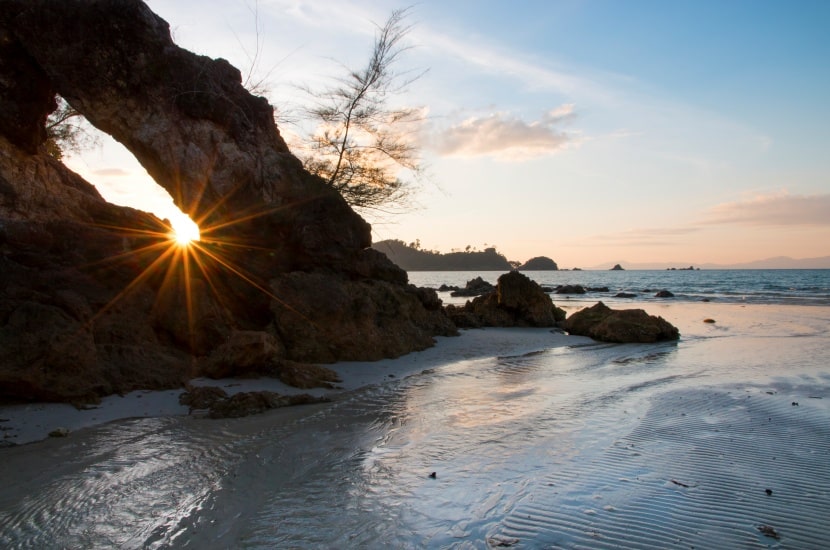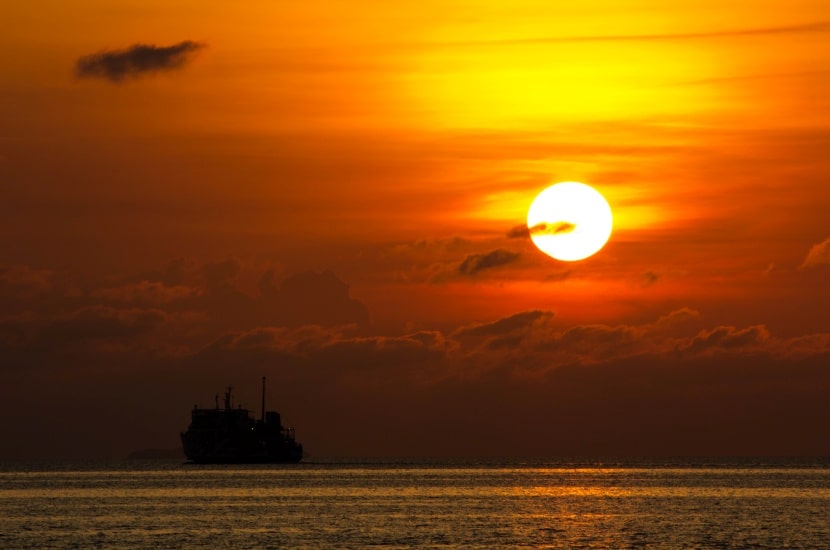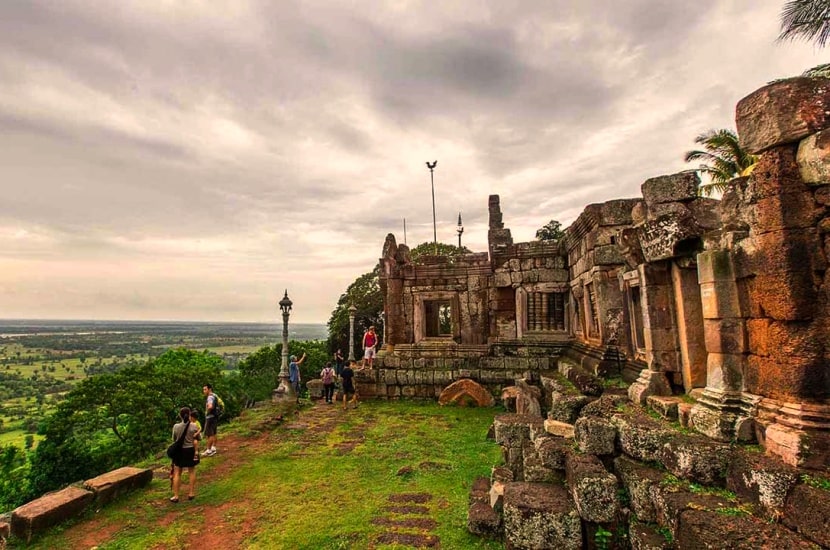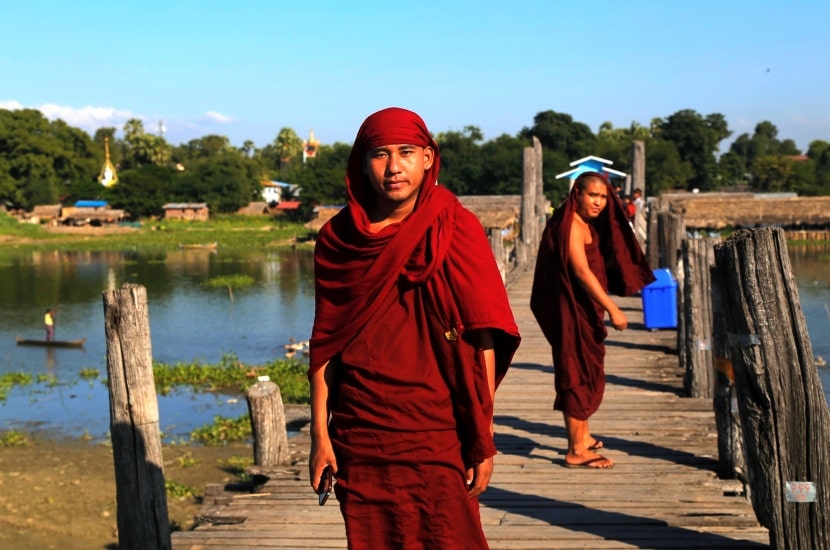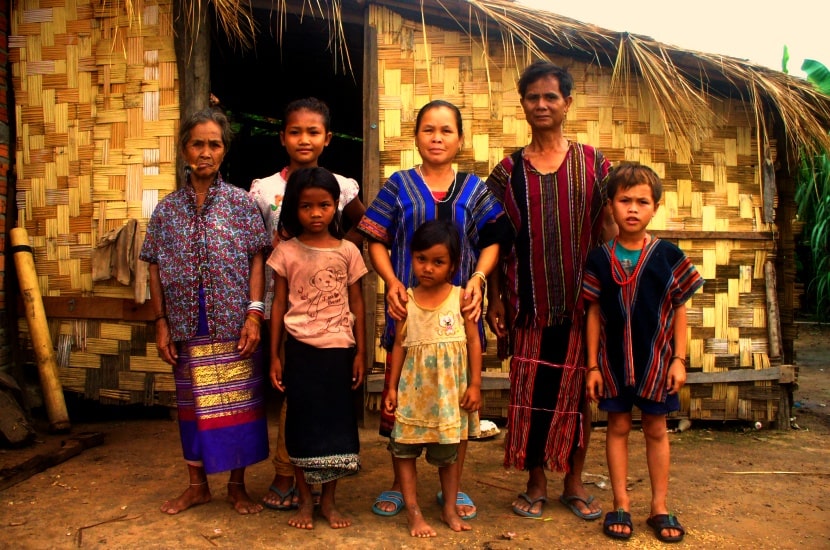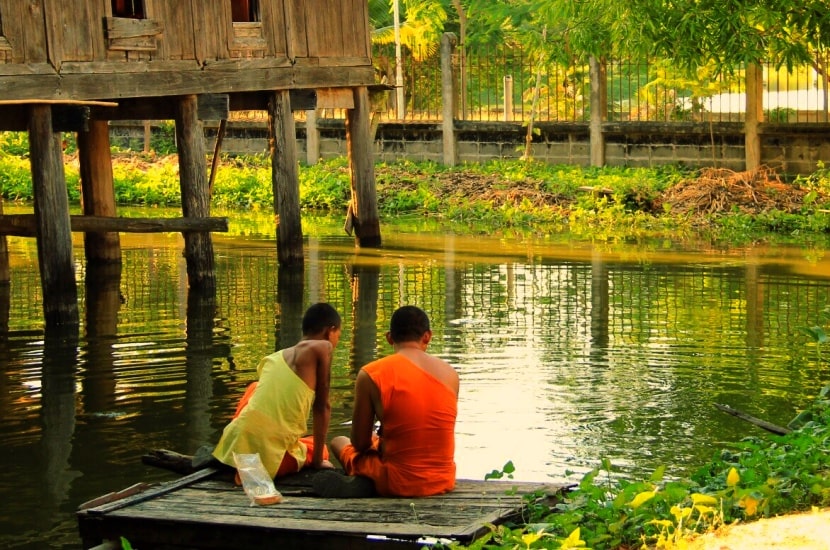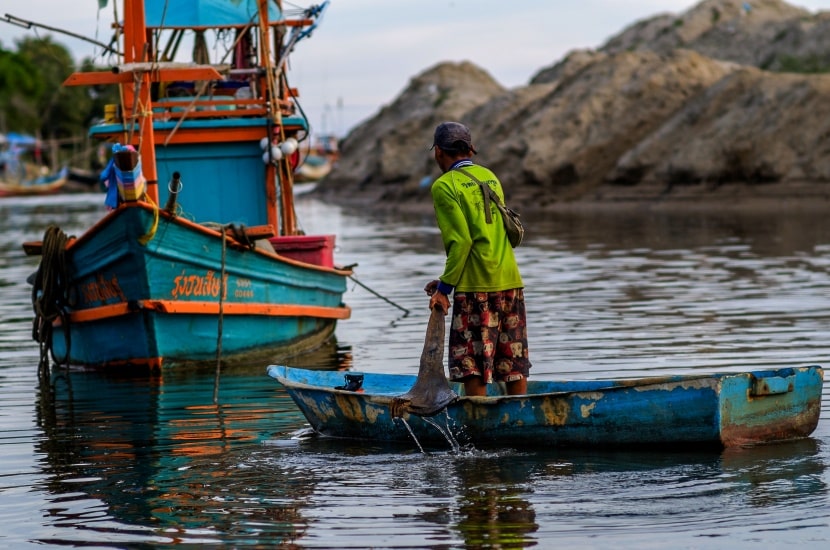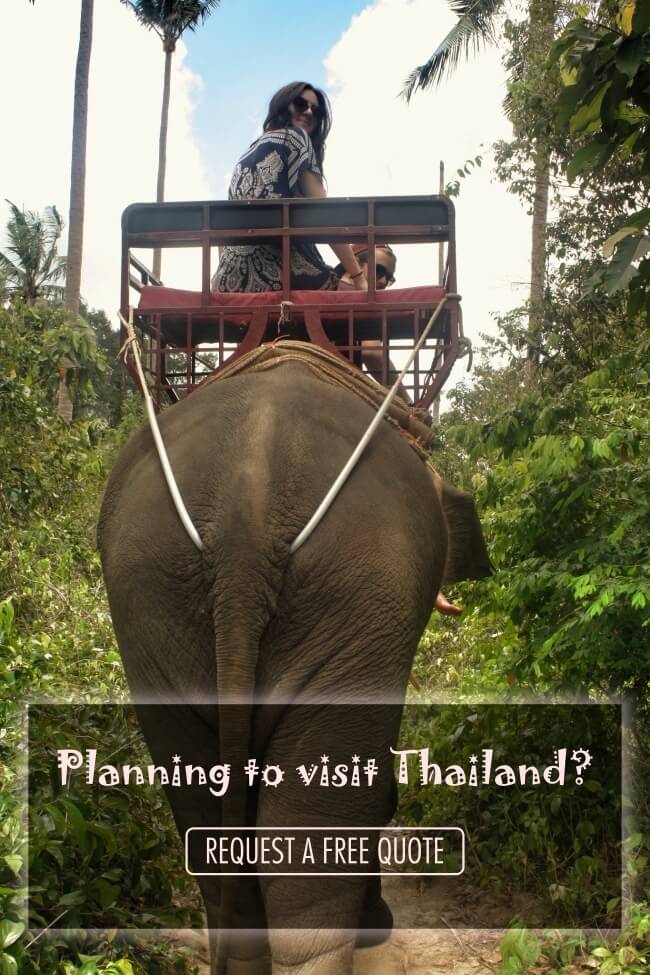Check the picture below to have the general idea of what you can expect throughout the year.
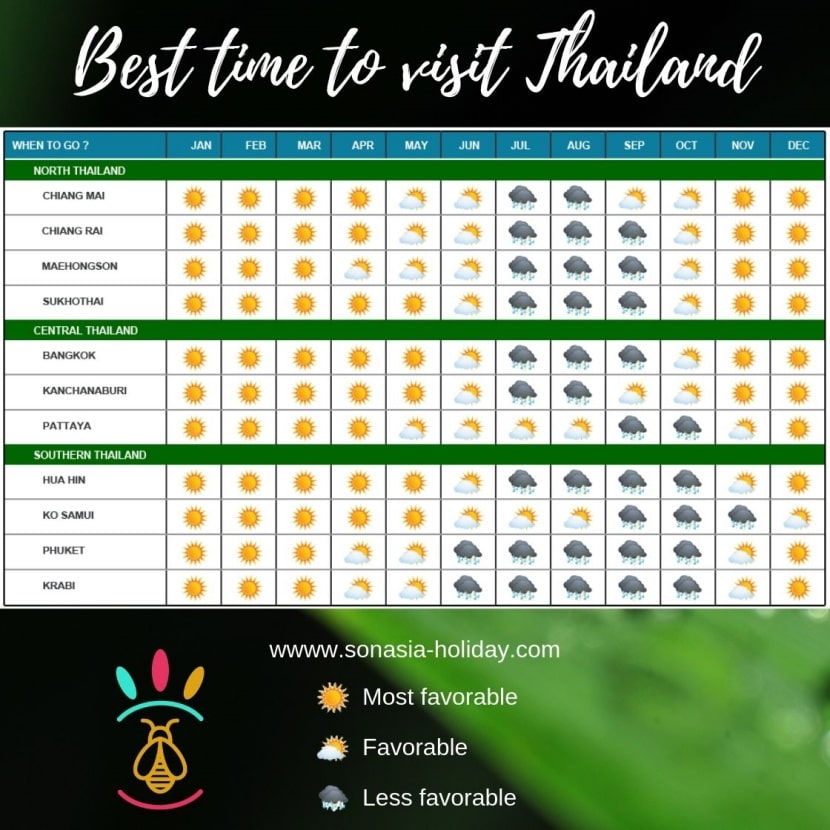
January
January is a peak time for tourism in Thailand, with the southern beaches on both coasts seeing hot sunny days, and the central and northern areas having cooler temperatures that are perfect for days trekking in jungles or sightseeing. Don’t forget to pack a lightweight sweater.
Accommodation prices are at a premium around the country, though you will still be able to find great deals if you head away from the tried-and-trodden track and explore less-visited areas. Beach lovers could swap Krabi and Phuket for Trang, a gorgeous southern gem.
This is also the perfect time of year to visit Sam Phan Bok, a natural wonder in Isan’s Ubon Ratchathani. Only accessible in the dry season, thousands of holes are scattered across the bed of the Mekong River.
In the north, the small village of Bo Sang springs to life for the annual Umbrella Festival. A great side trip from Chiang Mai, the festival is held over the third weekend of the month. It demonstrates the skilled traditional art of making the colourful paper parasols and there are parades, live music, traditional dancing, and plenty of food stands.
In the south, the Bay Regatta sees hundreds of vessels in the waters around Phuket, Phang Nga, and Krabi.
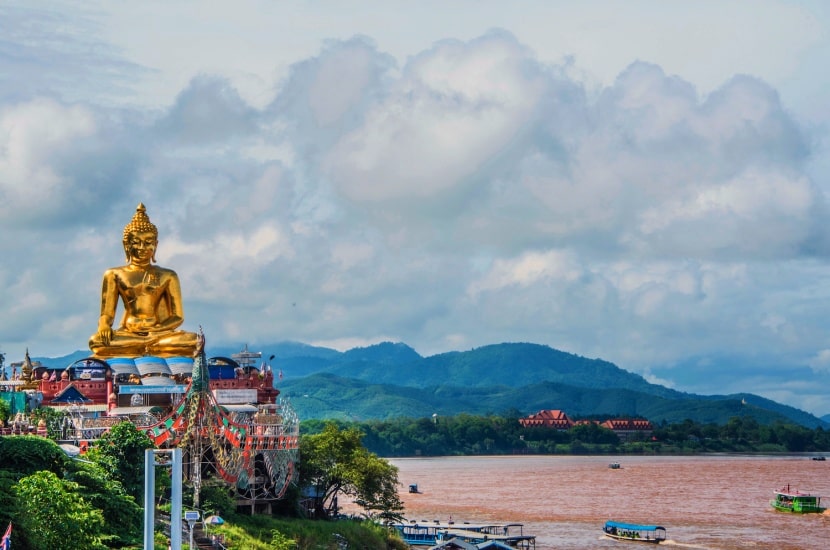
February
Another popular month for tourism, the weather is still good in most areas. While many places around the world are getting excited about Valentine’s Day, this isn’t such a big deal in Thailand. Instead, head to the Red Lotus Sea in Udon Thani for a romantic boat ride. Off the beaten track, the lake springs into bloom in the cool season, covered in beautiful pink lotus flowers.
Chinese New Year typically falls in February, though the exact dates vary from year to year. Go anywhere with a large Chinese population, like Bangkok’s Chinatown, to watch lion dances, acrobatic demonstrations, Chinese opera shows, dragon dances, and more.
The Buddhist celebration, and Thai national holiday of Makha Bucha is also often in February. (Precise dates vary each year.) Observe spiritual rituals in temples and see people making merit, praying, and chanting; Bangkok’s Wat Saket is especially atmospheric.
Alternatively, move away from the mainstream and head to Prachinburi’s Makha Bucha fair for processions, cultural demonstrations, and a lantern release.
Beach lovers can soak up the sun on either of Thailand’s southern coasts, with business booming in places like Phuket and Koh Samui, and Krabi Naga Fest brings music to the beaches.
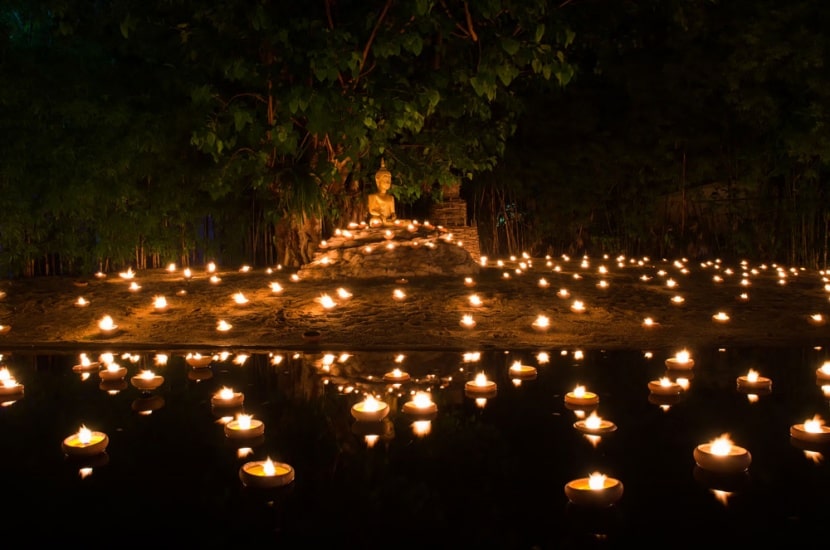
March
In March, temperatures start to really heat up. It’s prime time for diving in the Similan Islands and other places along the Andaman coast. Environmentalists and nature lovers should check out the Turtle Release Festival in Phang Nga. Chumphon Marine Festival is also lively, with sand sculptures, water sports, marine tourism, and seafood galore.
If you’ve ever wanted to soar above the skies in a hot air balloon, Thailand International Balloon Festival could be ideal. Generally held in March, the dates vary so do make sure to check in advance. Also, the location changes from year to year. The three-day Pattaya International Music Festival is one of Thailand’s best music festivals, and it’s completely free to attend.
National Muay Thai Day, on the 17th of March, is a great time to learn more about this traditional martial art and its long cultural associations. Although many stadiums and Muay Thai camps around the country have demonstrations and events, the ancient city of Ayutthaya is the best place for boxing fans to spend the day.
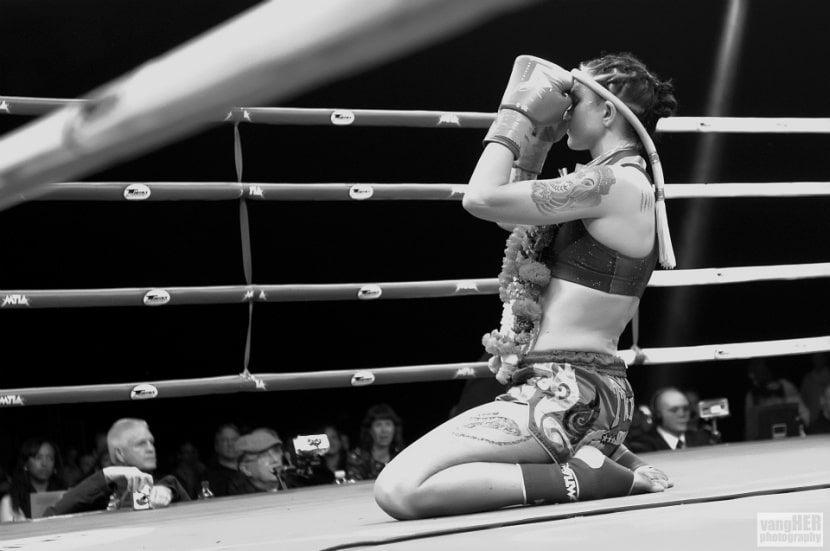
April
April is one of the hottest months in Thailand. Drink plenty of water, slap on the sunscreen, and make shade your friend. It is well worth paying the extra for accommodation with air-conditioning — fan rooms don’t really cut it in this heat.
April sees one of Thailand’s biggest festivals: Songkran. Famous for its huge nationwide water fights, celebrations for Thai New Year occur all around the country. The three public holidays are between the 13th and 15th, with extra days to compensate if these fall over the weekend. Bangkok, Phuket, and Chiang Mai are some of the best places to get wet and wild.
April is also traditionally the time that Thai men temporarily ordain as monks, with large ceremonies to mark the auspicious occasions. April the 6th is a public holiday that remembers the start of the Chakri Dynasty.
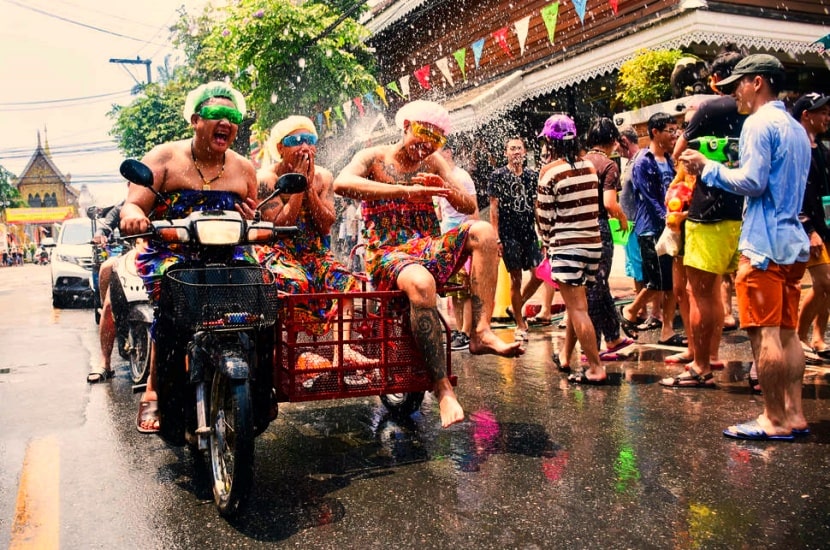
May
Another hot month in Thailand, May is a great time to visit some of Thailand’s more offbeat destinations and experience unusual festivals.
Love it or hate it, there’s no denying that durian makes itself known in Thailand. Chanthaburi, famous for its gem trade, hosts The World Durian Fruit Festival every May (exact dates vary), with competitions and games, sales fairs, parades featuring floats adorned with fruit, and lots of tasting opportunities.
If you want May to really go with a bang, visit Yasothon in Northeastern Thailand. Usually held on the second weekend of the month, Bun Bang Fai Festival sees locals launching many rockets into the skies in hopes of receiving rains.
Alternatively, see unusual monk ordination rituals in Chaiyaphum, with monks-to-be paraded around town on bamboo platforms, shaken vigorously along the route. It’s no wonder that the unique rituals are known as the Brutal Ordination Parade!
Dates for the Buddhist holiday of Visakha Bucha Day follow the lunar calendar and so vary each year. It’s usually in May or June. A public holiday, it is the most significant event for Thai Buddhists, commemorating the birth, enlightenment, and death of the Lord Buddha.
Temples up and down the nation are filled with people making merit. Some of the best places to observe local traditions are at Chiang Mai’s Doi Suthep and the Temple of the Emerald Buddha in Bangkok.
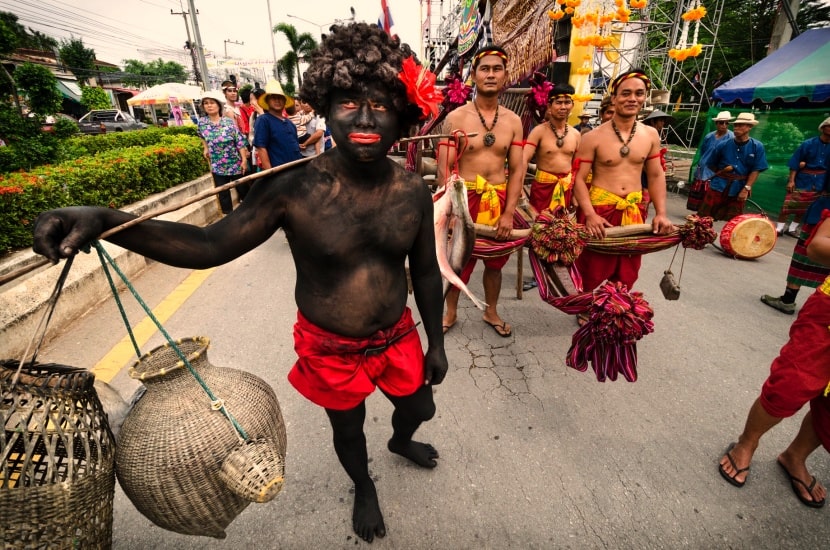
June
You’ll probably notice more showers by June and it pays to carry an umbrella and wear shoes that won’t slip. Take extra precautions when riding a scooter; Thailand’s roads can be lethal. Mellow out at Hua Hin Jazz Festival or admire the colourful fields of Siam tulips at Pa Hin Ngam National Park in Chaiyaphum.
If you’re heading north, don’t miss the Phi Ta Khon Festival in Dan Sai district of Loei province. A local spiritual festival, it features parades with people dressed in elaborate ghost costumes, complete with huge masks, and lots of music. The festival seeks to appease spirits and seek rains.
The exact dates vary each year and are set by sages and astrologers, but May is a fairly common month for the ghostly festival.
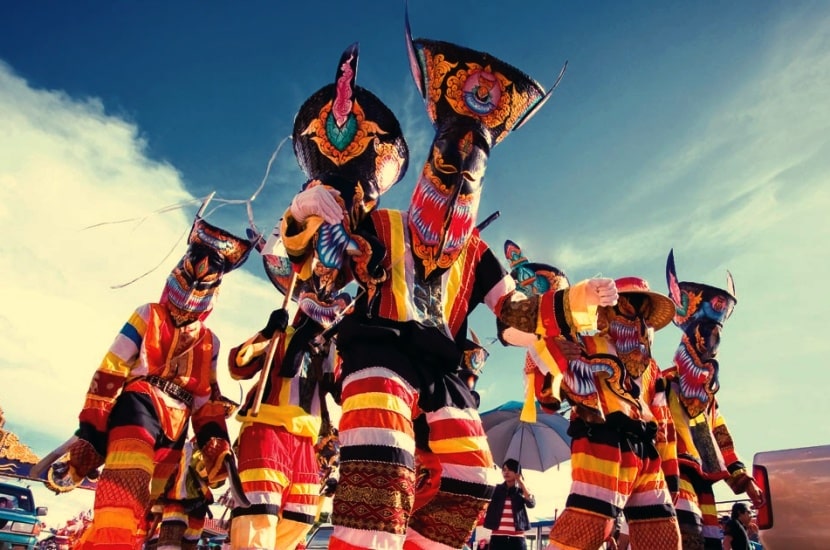
July
July is generally a pretty wet month all around Thailand, and it often feels very humid. Make mosquito repellent your best friend this month and don’t forget leech socks if venturing into the jungles.
Speaking of jungles, this can be a terrific month to visit national parks; the rains fill up the waterfalls and the landscapes are lush and fertile. Khao Yai National Park and Kanchanaburi’s Erawan National Park are especially beautiful.
The driest beaches and islands include Koh Samui, Koh Phangan, Hua Hin, and Cha Am. Fans of underwater explorations should don their diving gear and snorkelling equipment this month, with July and August the best (and busiest) times for diving around Koh Tao.
The 30th is the King’s birthday and a national holiday. The Buddhist holiday of Asahna Bucha is a national holiday too. Dates vary according to the lunar cycle. It marks the start of Vassa, often referred to as Buddhist Lent. Special ceremonies are held in temples around the country and the Central Thai province of Saraburi has a large religious parade.
Alternatively, head to Isan for Ubon Ratchathani Candle Festival. Huge wax sculptures are paraded through the streets and there’s lots of singing, dancing, and music. It’s a great way to enjoy local Northeastern Thai culture.
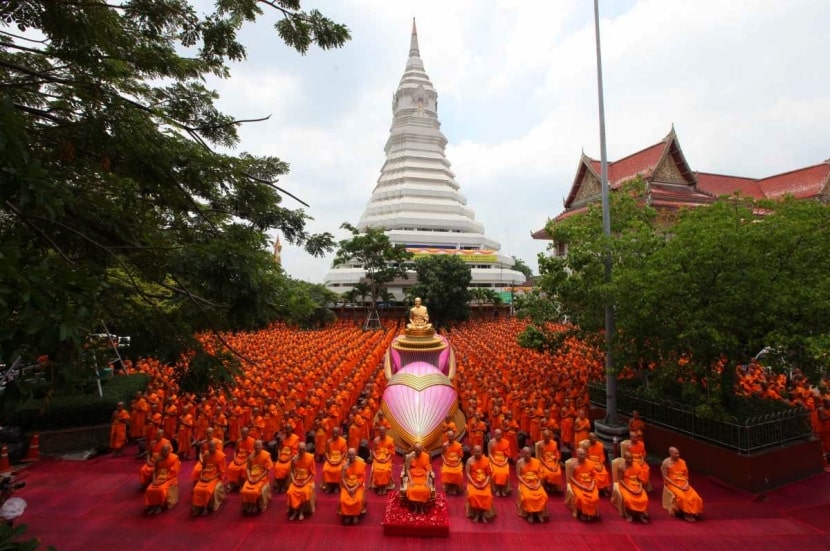
August
August is typically the wettest month all around Thailand. Prepare with rain ponchos, slip-proof shoes, and umbrellas. Backpackers should almost certainly make sure they have waterproof covers for their bags. Make a list of the best indoor activities; Bangkok’s many temples, museums, art galleries, and malls make it a perfect city come rain or shine.
August the 12th is the Queen’s birthday, Mother’s Day, and a national holiday. If you’re in Phuket in August you’ll witness Por Tor Hungry Ghost Festival, a time when people respect their ancestors and make offerings to spirits.
Foodies should add Hua Hin Food Festival to their itinerary, and the Akha Swing Festival in Chiang Rai offers a glimpse into fascinating traditions from one of Thailand’s ethnic groups.
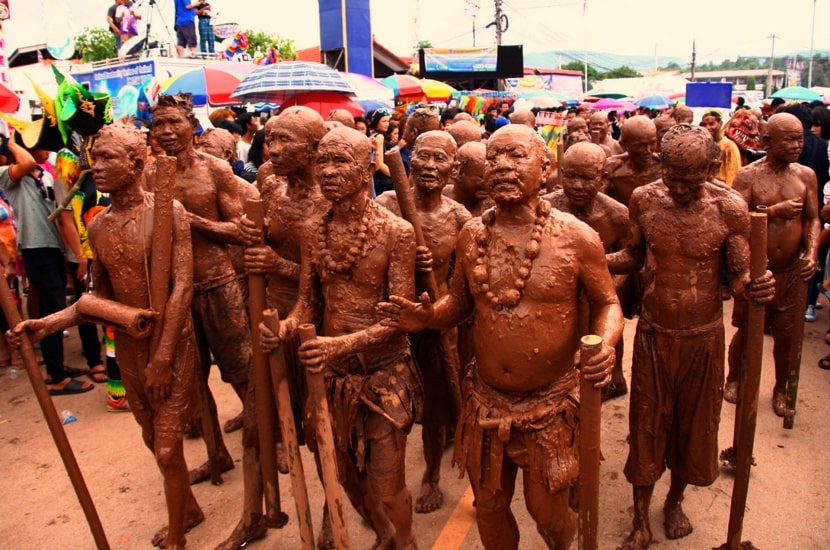
September
The rains ease in September, except for the Andaman coast — this is the wettest time here. Around the country, waterfalls flow with abundance and the rivers are at their fullest.
September usually sees the start of long boat races, held on many rivers nationwide. The atmosphere is often electric, with roaring crowds, carnival-like games, street food galore, and traditional performances. Phitsanolok, Petchaburi, Singburi, Naan, and Surat Thani are just a few places where you can watch the age-old traditions on the water.
The multi-day Bangkok International Festival of Dance and Music draws large crowds, with musical performances from diverse genres, dance shows, operas, ballets, and more. For something really unusual, visit Lam Dome Yai in Ubon Ratchathani.
Every year, thousands of little shrimps make their way up the stream, clambering out of the water to march along the riverbanks to bypass the raging waters of the rapids before climbing back down into the water again.
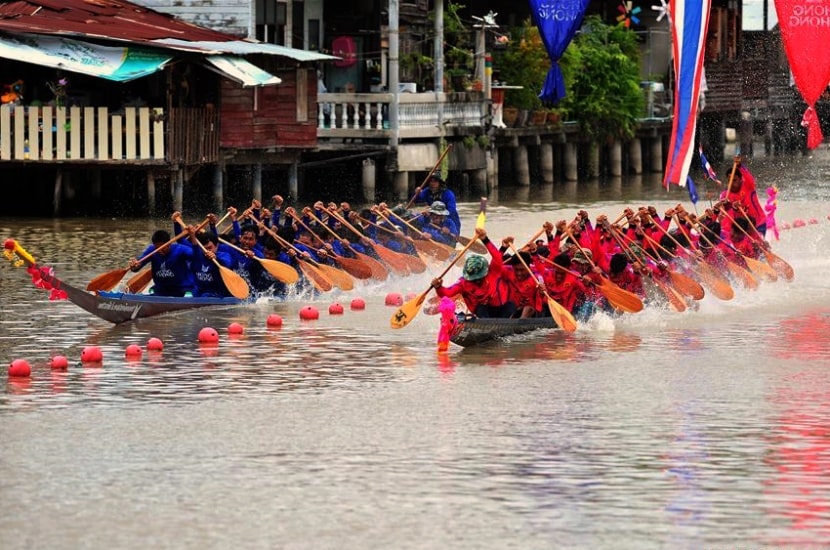
October
Central, Northern, and Northeastern Thailand are mostly dry and the temperatures start to fall. Almost all of the islands, however, are wet. This is the ideal time to visit anywhere from Bangkok upwards before large crowds appear. The popular hippy hangout of Pai is especially great in October.
Also in the north, the Naga Fireballs of Nong Khai are strange phenomena that usually appear towards the end of the month. Mysterious balls of fire erupt from the Mekong River, said to be the work of the mythical Naga.
In Nakhon Phanom, the end of Buddhist Lent is marked with a beautiful illuminated boat procession. Various festivities mark the occasion around the country.
Many southern provinces have large and colourful vegetarian festivals, ideal for any meat-free foodie. Phuket’s Vegetarian Festival is especially well known, with gory rituals that involve self-mortification and fire walking.
Loi Ruea Chao Le Festival on Koh Lanta is a great chance to learn more about the Moken people, also known as sea gypsies. Based on the lunar calendar, the dates vary. People float boats on the waves and rejoice with traditional dancing and singing.
October the 13th is a public holiday to remember the passing of the beloved former Thai king, King Bhumibol. It is likely to be a very sombre day throughout the country. The 23rd is another national holiday honouring a former Thai king: King Chulalongkorn.
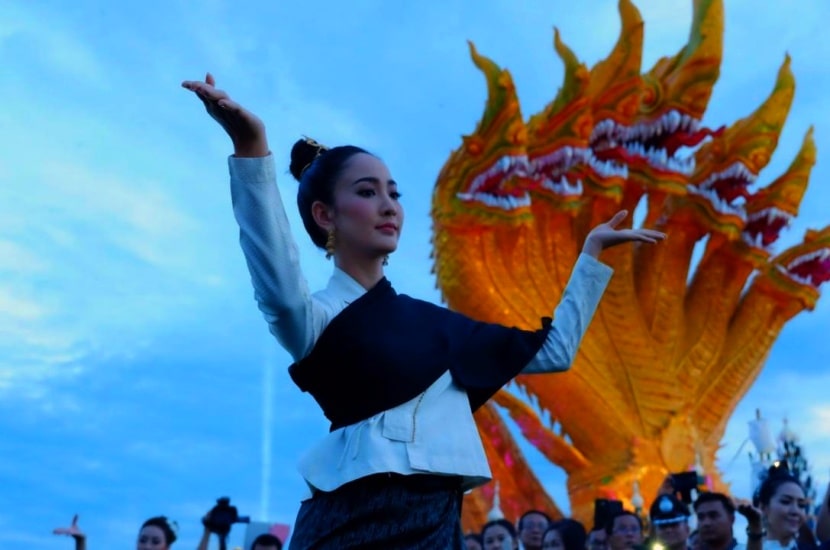
November
The dry season is well underway in most parts of Thailand, with moderate temperatures and plenty of sunshine. Beach lovers will be delighted that the Andaman coast is now at its best, along with Koh Chang and other islands along the eastern Gulf. The western Thai Gulf is, however, still rainy and stormy.
Mid-November (dates vary) sees one of Thailand’s loveliest festivals: Loy Krathong. Celebrated around the country, people float pretty krathongs on the rivers to give thanks to the water spirits. The north of Thailand has an extra celebration around the same time, known as Yee Peng.
Famous for its stunning lantern releases, Chiang Mai is one of the best places to experience this beautiful festival.
Originally established as a way to honour elephants, Surin Elephant Roundup (third weekend of November) features a large buffet breakfast for the beasts and several shows. Don’t miss the nearby sound and light shows at the ancient ruins of Prasat Sikhoraphum.
Another unusual celebration with an animal focus is Lopburi Monkey Feast. It takes place on the last Sunday of November and is a bizarre spectacle to witness!
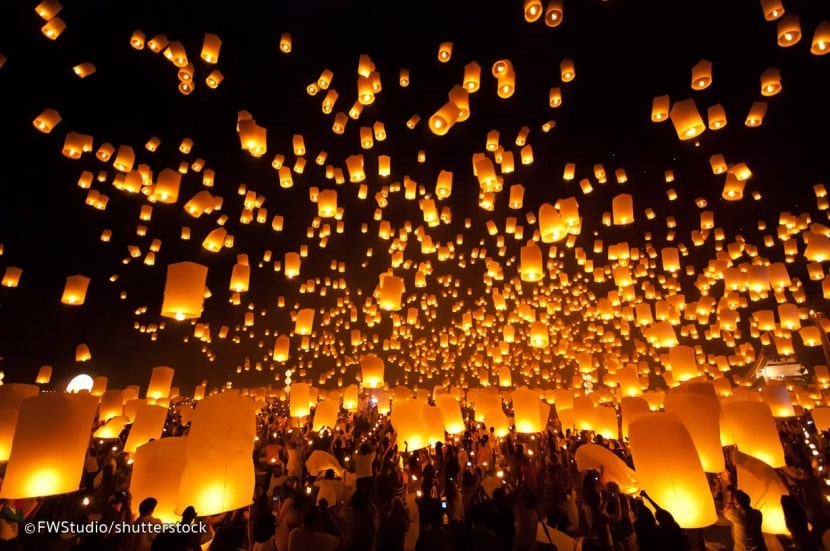
December
December is one of the peak tourism months in Thailand, with great weather all around the country. Temperatures are, for the most part, comfortable, without being too hot or too cold. There’s little to no rainfall, and the beaches have lots of sun.
There are several national holidays during this month. The fifth is the birthday of the late King Bhumibol, and is also when Thai people celebrate Father’s Day. The 10th is Constitution Day.
For war history, don’t miss River Kwai Bridge Week in Kanchanaburi (held in November or December).
For something novel, visit Loei province; it’s the only province in Thailand where temperatures can dip to freezing in the cool season. Ayutthaya World Heritage and Red Cross Fair has stunning sound and light shows amid the ancient ruins. Phetchaburi hosts one of the biggest and oldest music festivals in the Land of Smiles: Big Mountain Music Festival.
Christmas isn’t such a big deal in Thailand, though many malls do have festive decorations. For a true Thai Christmas, however, head to Sakhon Nakhon province.
Home to Thailand’s largest Christian population, the province has an enchanting Christmas Star Parade, with many cultural and religious activities, between the 23rd and 25th. And of course, New Year is huge all around the Land of Smiles.
